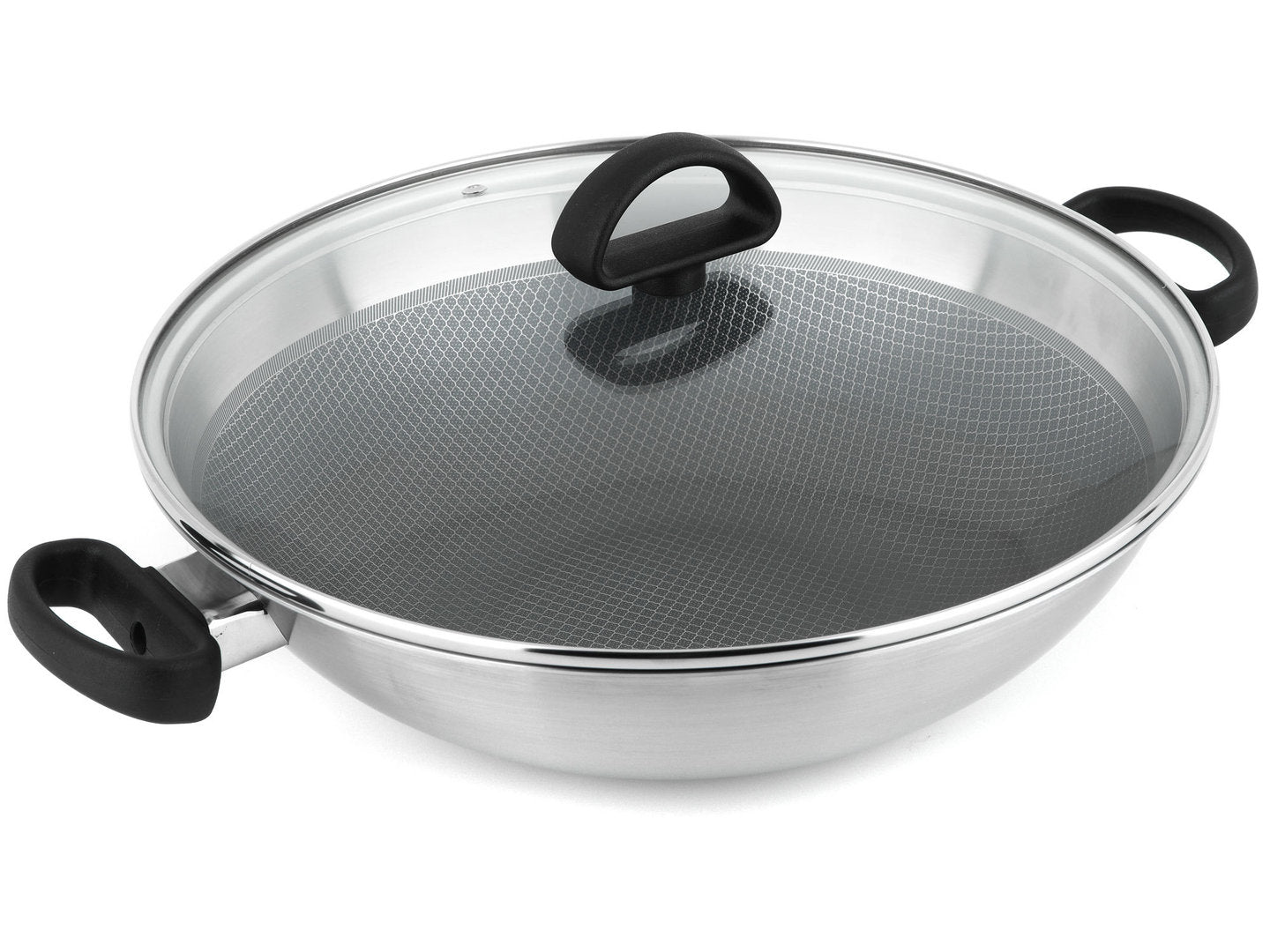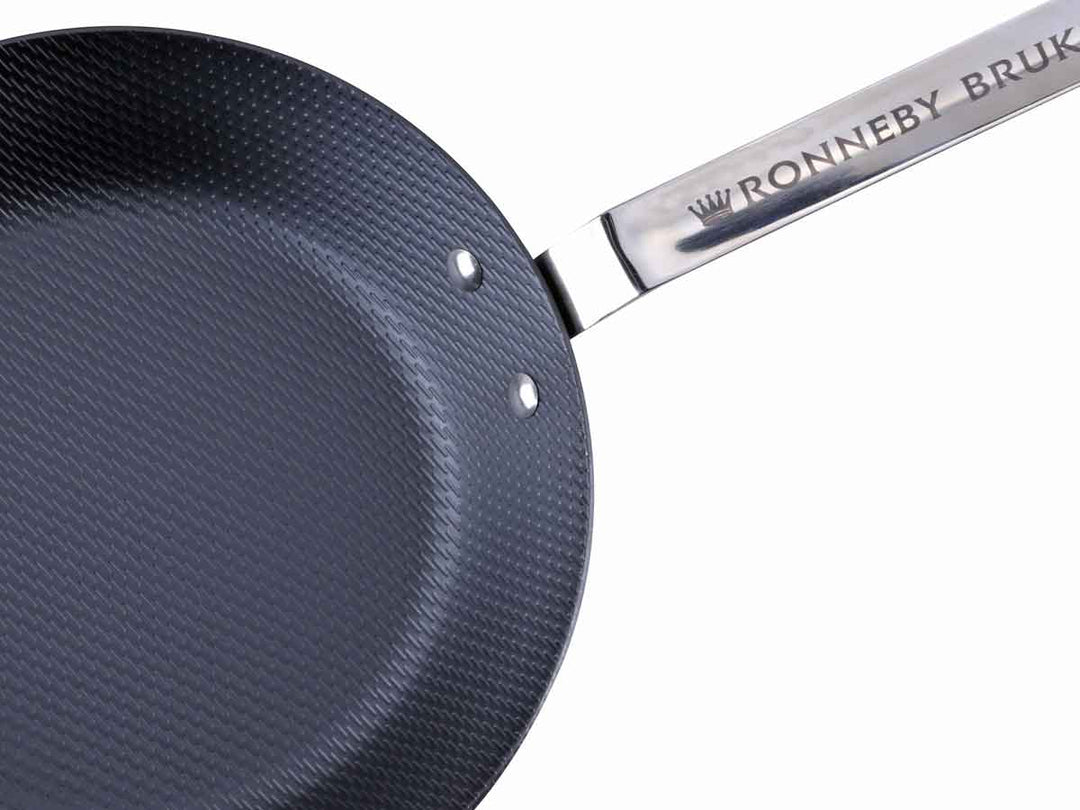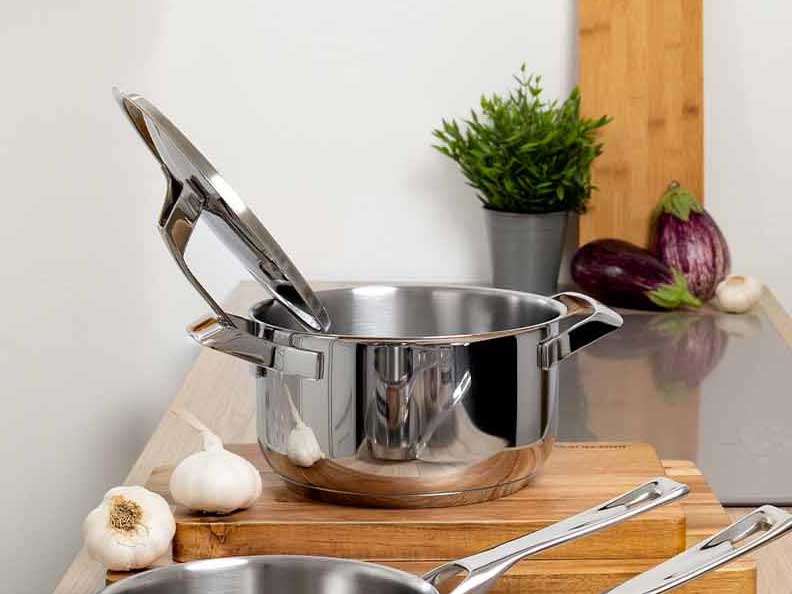Cleaning cookware
Here we want to give you hints, tips and tricks for cleaning and care of pots and pans. Proper care prolongs the life of the product and maintains its beautiful appearance. Depending on the material and/or coating, different aspects should be considered for cleaning and care:
How to clean cookware with a non-stick / ceramic coating
Cookware with a non-stick or ceramic coating is a breeze to clean. Hot water, dishwashing liquid and a microfiber cloth are usually sufficient for thorough cleaning. You can also use a sponge cloth or a normal dishcloth, but with a microfiber cloth you will achieve the best results and effortlessly remove even the finest smear films that a normal cloth / sponge cannot get rid of in one wipe.
For coarser dirt, you can use a soft dish brush. Then wipe with a microfiber cloth.
Is wiping with a paper towel enough?
You sometimes see it on commercial television to illustrate the ease of care of the advertised coating, but no, merely wiping out the non-stick/ceramic coated cookware with a piece of kitchen paper is not enough in our opinion. The dirt visible on the surface will sometimes be removed, but a thin smear film will remain. In addition, when wiping out with the paper towel, there is a certain risk of creating fine surface scratches if hard particles in the oil film (undissolved salt or charred breadcrumbs, for example) are rubbed over the coating.
What should you not use to clean a non-stick or ceramic coating?
- Steel wool
- Rough sponges / pot scrub sponges / scouring pads (Exception: There are also special scrub sponges for non-stick coatings on the market. Pay attention to the manufacturer's instructions and, when having different sponges at the sink, pay attention to the color difference between the different sponges)
- Scouring milk and the like
- Grill cleaner brushes and the like
- strong solvents or bleach
- intensive cleaner
Do not forget the outer base (contact surface)
The contact surface of cookware is often neglected during manual cleaning. Thus, smear films remain there, which polymerize / burn in during the next heating and leave a stubborn brownish layer. Therefore, also carefully rub the outer base with the rag during each rinsing process.
If unsightly brown layers have already formed on the outer base / contact surface, they can certainly be removed again. To do this, place the pot / pan upside down on a soft cloth so that the edge is not scratched. Then apply a squirt of mild, sand-free scouring milk to the outer bottom and rub until the brown layers are removed. Important: Really only treat the uncoated parts of the outer base like this! Then rinse thoroughly with clean water.
Non-stick cookware in the dishwasher?
Here, first of all, an important distinction: When we talk about non-stick coating, we mean classic PTFE-based coating systems. We do not mean ceramic (non-stick) coatings! Ceramic-coated cookware is generally not dishwasher-safe!
In any case, pay attention to the manufacturer's instructions for use. Most PTFE-based non-stick cookware is in principle dishwasher-safe. However, we recommend cleaning PTFE-based non-stick coatings by hand in any case, because the hard water jet of the dishwasher has an abrasive effect on the coating in the long run, so that it wears out faster.
In addition, similar to bowls and dishes made of plastic, water staining can occur on the non-stick coating during the drying process in the dishwasher because the water droplets hang like fine beads on the non-stick surface and dry there if they remain there for a long time after the rinsing process in the dishwasher. It is best to remove the non-stick cookware from the machine as soon as possible after washing and dry it by hand. Therefore, preferably select a program without drying.
Caution: When cleaning aluminum cookware in the dishwasher, permanent whitish to dark gray staining can occur in the area of the contact surface, where bare, machined aluminum can be seen, because the aluminum oxidizes. Unlike rust in iron, however, this oxidation is not progressive and is therefore harmless. Preferably, select a short program without a drying phase and remove the non-stick cookware from the dishwasher immediately after the end of the program to minimize oxidation marks.
Rub non-stick coating with oil after cleaning?
In principle, you do not need to do this. Neither do nonstick coatings have pores that need to be "saturated" with oil, nor does rinsing somehow "leach" the coating.
However, some manufacturers still recommend rubbing the nonstick coating with oil after cleaning. Why? Quite simply, the thin film of grease ensures that any impending overheating of the pan due to the smoke point of the oil becomes visible to the user before temperatures are reached that irreversibly damage the coating. The thin oil film is therefore a certain safety feature.
How to clean cookware with enamel coating
Enamel is a glass-like coating that is typically applied to either cast iron or steel in the cookware area, where it is melted on the material at high temperatures (800-900° C).
Due to the non-porous surface of the enamel, enameled cookware is quite easy to clean. Depending on the model, enameled cookware can therefore even be easily cleaned in the dishwasher. (Be sure to follow the manufacturer's instructions!)
If you wash the enameled cookware by hand, hot water, dishwashing detergent and a dishwashing brush are sufficient. Stubborn food residues can be soaked in hot water for some time or even boiled briefly. Then rework with the dishwashing brush.
Stubborn stains on the enamel can be removed with a mild, sand-free scouring milk. Then rinse well.
After rinsing, dry the enameled cast iron cookware thoroughly. Caution: the edges of enameled cookware are often not or not completely enameled for production reasons, because the cookware was upside down on the firing rack in the kiln at these points. It is therefore very important to pay special attention to these edges after rinsing and drying. Depending on the manufacturer's recommendations, it makes sense to wet the edge areas with a little cooking oil; to do this, put a few drops of oil on a lint-free cloth and run it over the edge of the cookware.
What should you not use to clean enameled cookware?
- Steel wool and scouring pads
- grill cleaner brushes, etc.
- strongly acidic and corrosive liquids
- strong solvents or bleach
How to clean cookware made of uncoated stainless steel
Stainless steel is a very robust and relatively easy-care material. For basic cleaning, hot water, washing-up liquid and a dishcloth are sufficient; for stubborn residues, add a washing-up brush and / or a non-scratching scouring pad/sponge. If something is heavily burnt, then soak the incrustation first with hot water and detergent.
Boiling hard water causes grayish-white lime spots to appear on the inside bottom of uncoated stainless steel cookware. These can be easily removed in no time at all with a dash of vinegar essence or, much more odorless, citric acid (not to confuse with lemon juice) and a dishwashing brush.
If the empty cookware is heated to a very high temperature, a rainbow-like discoloration of the stainless steel may appear on the bottom of the cookware. This is a normal property of steel and is completely harmless.
Some foods may leave shadow-like stains on the stainless steel surface after prolonged contact (storing prepared food in the cookware). This is also normal and completely harmless.
To remove stains and discoloration, simply use a conventional stainless steel polish or a mild, sand-free scouring cream. Especially with mirror-finished surfaces, make sure that you really do not use any scratching cleaning agents or pads, so as not to impair the reflective appearance with fine scratches.
Cleaning in the dishwasher is mostly possible with uncoated stainless steel (follow the manufacturer's instructions), but traces of burnt-on residue or lime stains from cooking may remain after cleaning in the dishwasher. This means that either preparatory work before or follow-up work after cleaning in the dishwasher may be necessary, which is why it may seem sensible to wash heavily soiled stainless steel cookware completely by hand straight away.
Rust stains on stainless steel can occur in rare cases. Usually these are transferred rust particles from another object that is not stainless steel. Flash rust can usually be removed by polishing with stainless steel care or mild scouring milk.
Caution, never use cleaning agents containing chlorine on stainless steel!
How to clean cookware made of raw, uncoated cast iron or carbon steel
Cookware made of raw cast iron or carbon steel has no artificial coating. However, cast iron in particular is usually pre-seasoned with oil at the factory to protect the surface from rust and to make it easier to use from the start.
Put raw cast iron or carbon steel pan in the dishwasher?
No, absolutely not! Cookware made of raw cast iron or carbon steel without a protective enamel coating should never be put in the dishwasher. Otherwise, large areas of rust would inevitably occur!
Therefore, cookware made of raw cast iron and carbon steel should always be washed by hand and as soon as possible after use. Attention: do not quench hot cookware! Let the hot pan cool down a little, then rinse it thoroughly while it is still warm to the touch with hot water and a strong dishwashing brush.
If possible, you should avoid using dishwashing detergent, especially with raw cast iron, where in the initial phase when the pan is new not all the "pores" of the surface are yet sufficiently covered with a stable seasoning layer. A certain light film of oil remaining on the surface is quite desirable with cookware made of raw cast iron and carbon steel. If very intensely smelling foods have been fried, it may still be appropriate to use some dishwashing liquid to remove odorants bound in the oil. After using dishwashing detergent, raw cast iron cookware should be rinsed particularly thoroughly with plenty of clean water to ensure that no detergent residue remains in the pores of the cast iron.
Particularly stubborn incrustations in raw cast iron and carbon steel pans can also be tackled with a scouring pad or, as a last resort, steel wool if the dishwashing brush fails. However, you will most likely scrub away parts of the baked-on layer in the process. But that's not really a problem, because you can easily re-season your cast iron or carbon steel pan at any time if necessary.
Very important: Never leave cookware made of raw cast iron or carbon steel in the rinse water! Danger of rusting!
Immediately after washing, dry the cast iron/carbon steel cookware very thoroughly all around. In the case of cast iron, it is best to heat the cookware again briefly on the stove to drive out all residual moisture from the pores of the cast iron.
When the cookware is completely dry, rub the entire interior surface with a lint-free cloth moistened with oil. This will protect the seasoned surface well and prepare it perfectly for the next use.
Cast iron smells musty and unpleasant?
If your raw cast iron cookware smells unpleasant, you probably haven't dried it sufficiently and / or stored it covered with a lid or similar in the kitchen cupboard. This is something to avoid. Always store cast iron open. So, if at all, place the lid only tilted (leave air gap) or store the lid separately.
Black abrasion in the cast iron pan?
If you rub seasoned cookware, especially raw cast iron, dry after rinsing, it is very likely that the drying cloth will turn somewhat black. This is caused by residual burnt-on grease that contributes to the seasoning layer. When rubbing down the frying surface, here and there such particles come out of the "pores" of the cast iron and can then be seen in the rinsing cloth. So, don't panic, there is no artificial coating coming off here, and the pan is not dirty either. The longer and more often the pan is used, taking good care of it, the smoother the surface will become, so there will be fewer black marks visible in the drying cloth.






